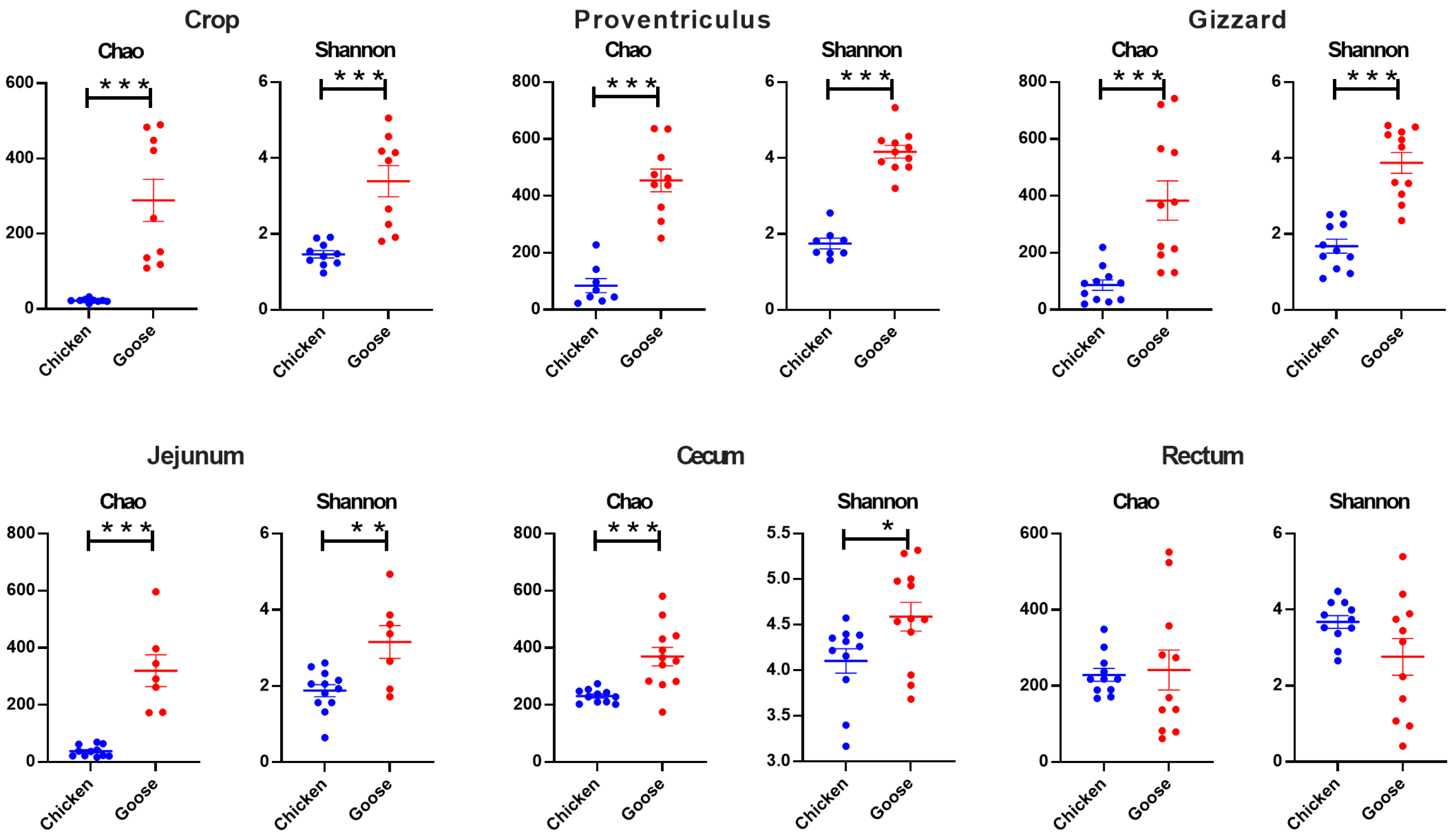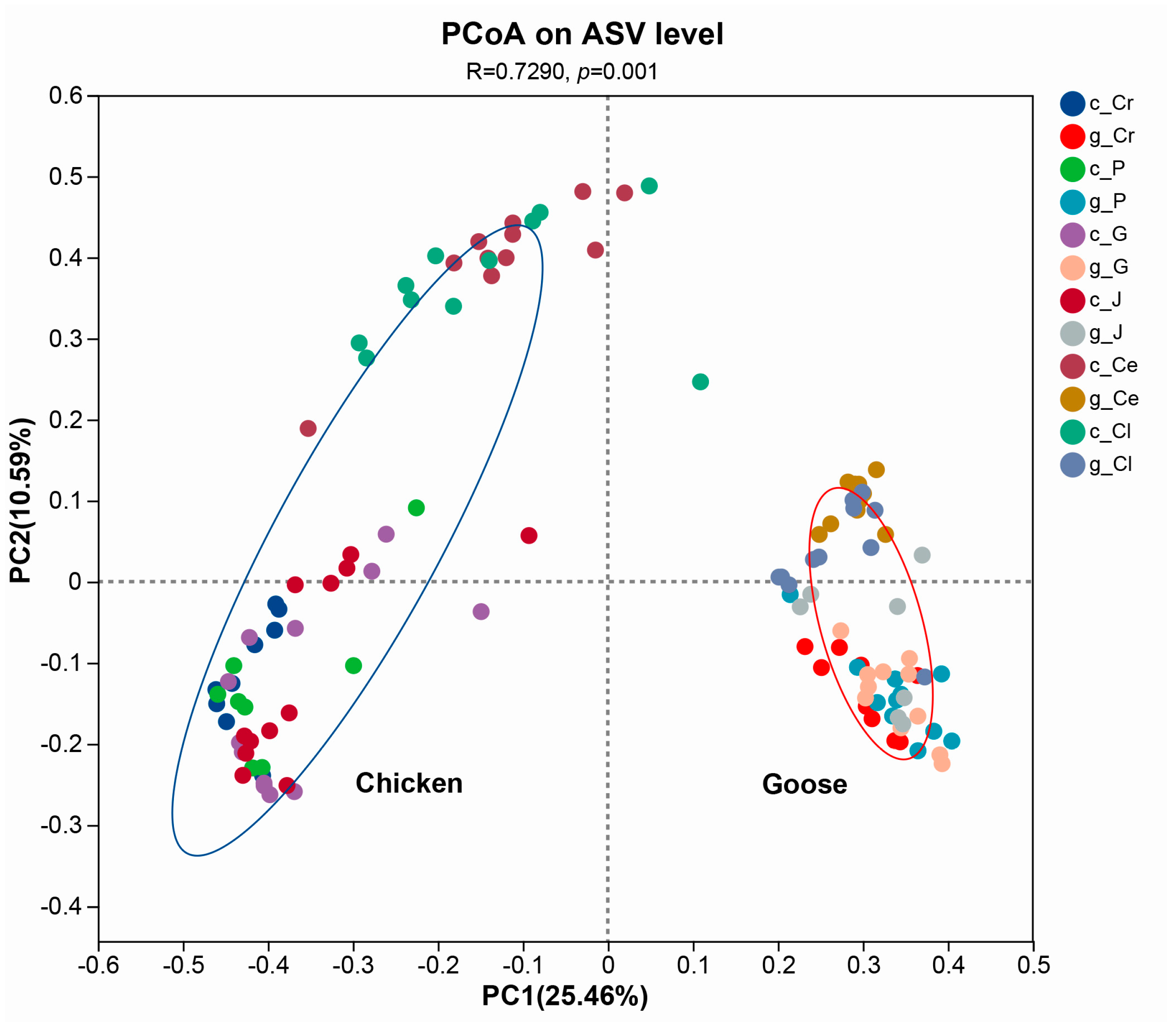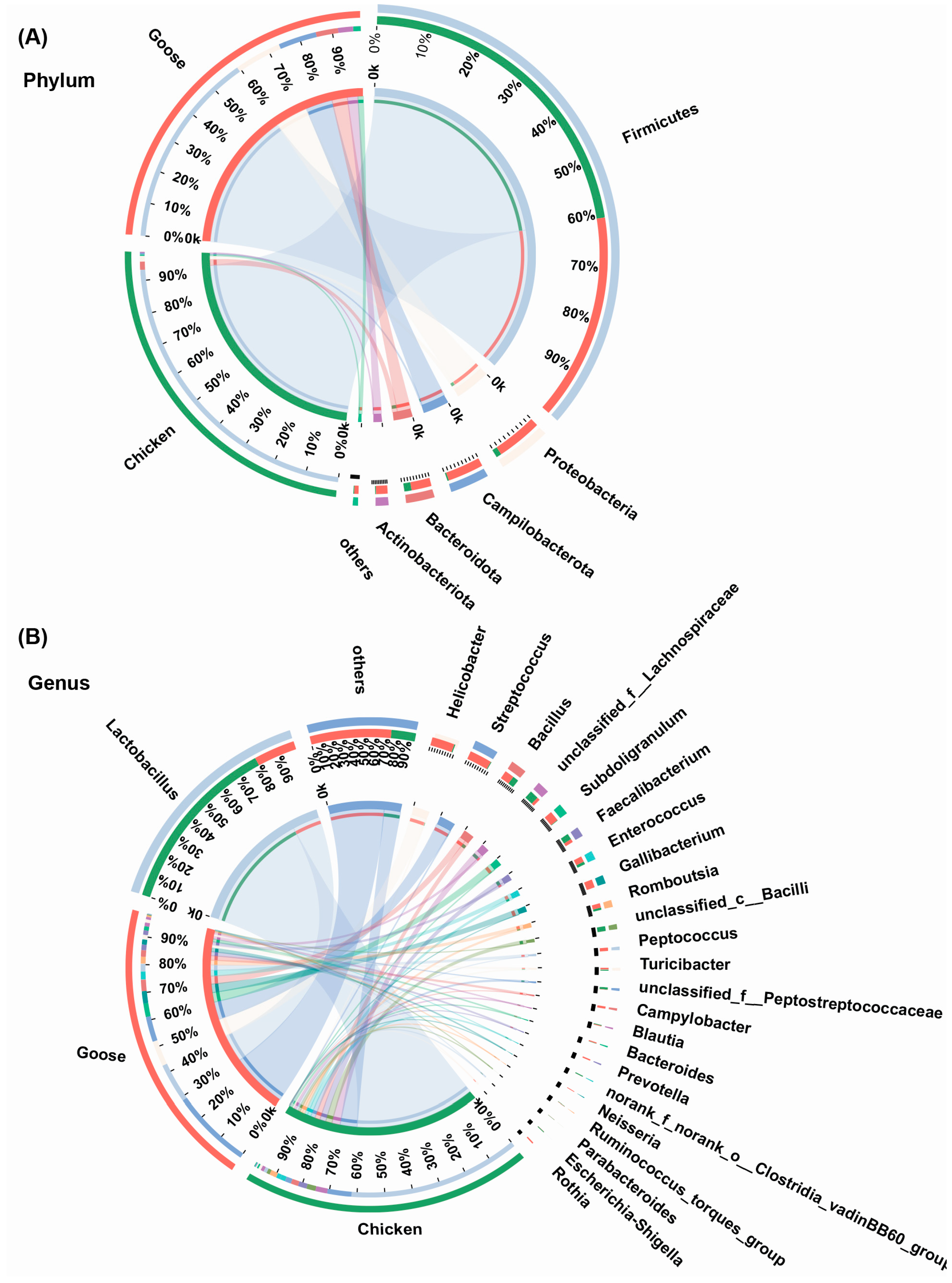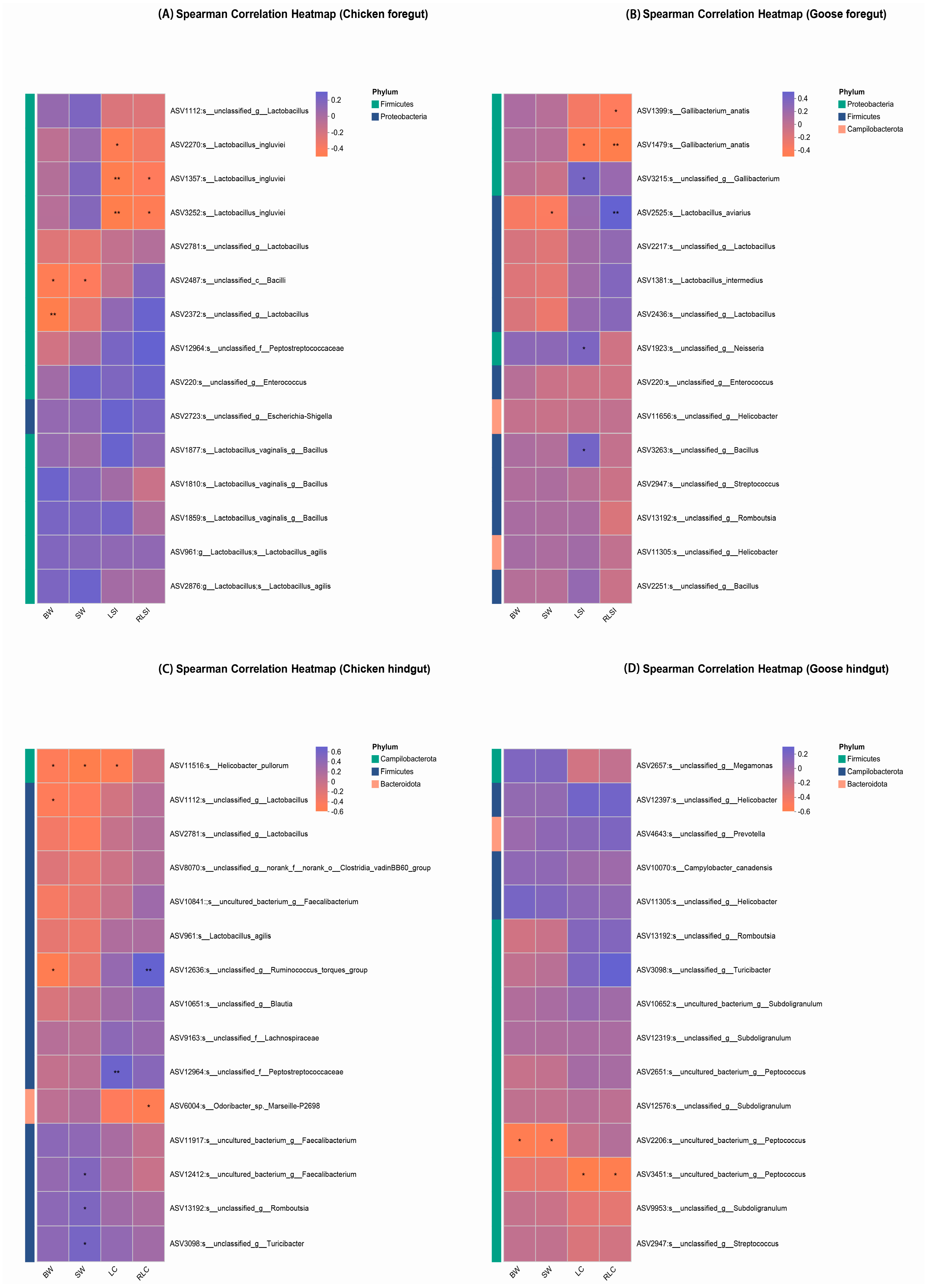Region-Specific Gut Microbiome Variation Between Changle Geese and Yellow-Feathered Broilers: Correlations with Growth and Intestinal Development
Abstract
1. Introduction
2. Materials and Methods
2.1. Ethics Approval
2.2. Experimental Diets
2.3. Experimental Animals and Rearing Environment
2.4. Sample Collection
2.5. DNA Extraction and 16S rDNA Sequencing
2.6. Sequencing Data Analysis
2.7. Statistics
3. Results
3.1. Phenotype Comparison
3.2. Shared and Unique ASVs
3.3. Alpha and Beta Diversity Analysis
3.4. Community Composition Analysis
3.5. Core ASVs Analysis
3.6. Correlation Analysis Between ASVs and Phenotypes
4. Discussion
5. Conclusions
Supplementary Materials
Author Contributions
Funding
Institutional Review Board Statement
Informed Consent Statement
Data Availability Statement
Acknowledgments
Conflicts of Interest
References
- Abadula, T.A.; Jilo, S.A.; Hussein, J.A.; Abadura, S.Z. Poultry Production Status, Major Constraints, and Future Prospective. J. World’s Poult. Sci. 2022, 1, 22–28. [Google Scholar] [CrossRef]
- Abouelezz, K.F.M.; Wang, Y.; Wang, W.; Lin, X.; Li, L.; Gou, Z.; Fan, Q.; Jiang, S. Impacts of Graded Levels of Metabolizable Energy on Growth Performance and Carcass Characteristics of Slow-Growing Yellow-Feathered Male Chickens. Animals 2019, 9, 461. [Google Scholar] [CrossRef]
- Chen, H.; Wu, Y.; Zhu, Y.; Luo, K.; Zheng, S.; Tang, H.; Xuan, R.; Huang, Y.; Li, J.; Xiong, R.; et al. Deciphering the Genetic Landscape: Insights into the Genomic Signatures of Changle Goose. Evol. Appl. 2024, 17, e13768. [Google Scholar] [CrossRef]
- Hunt, A.; Al-Nakkash, L.; Lee, A.H.; Smith, H.F. Phylogeny and Herbivory Are Related to Avian Cecal Size. Sci. Rep. 2019, 9, 4243. [Google Scholar] [CrossRef]
- Qin, S.; Zhang, K.; Applegate, T.J.; Ding, X.; Bai, S.; Luo, Y.; Wang, J.; Peng, H.; Su, Z.; Xuan, Y.; et al. Dietary Administration of Resistant Starch Improved Caecal Barrier Function by Enhancing Intestinal Morphology and Modulating Microbiota Composition in Meat Duck. Br. J. Nutr. 2020, 123, 172–181. [Google Scholar] [CrossRef]
- Fathima, S.; Shanmugasundaram, R.; Adams, D.; Selvaraj, R.K. Gastrointestinal Microbiota and Their Manipulation for Improved Growth and Performance in Chickens. Foods 2022, 11, 1401. [Google Scholar] [CrossRef] [PubMed]
- Kobayashi, R.; Nagaoka, K.; Nishimura, N.; Koike, S.; Takahashi, E.; Niimi, K.; Murase, H.; Kinjo, T.; Tsukahara, T.; Inoue, R. Comparison of the Fecal Microbiota of Two Monogastric Herbivorous and Five Omnivorous Mammals. Anim. Sci. J. 2020, 91, e13366. [Google Scholar] [CrossRef]
- Fu, R.; Xiang, X.; Dong, Y.; Cheng, L.; Zhou, L. Comparing the Intestinal Bacterial Communies of Sympatric Wintering Hooded Crane (Grus monacha) and Domestic Goose (Anser anser domesticus). Avian Res. 2020, 11, 13. [Google Scholar] [CrossRef]
- Xu, X.; Fan, S.; Wu, H.; Li, H.; Shan, X.; Wang, M.; Zhang, Y.; Xu, Q.; Chen, G. A 16S RNA Analysis of Yangzhou Geese with Varying Body Weights: Gut Microbial Difference and Its Correlation with Body Weight Parameters. Animals 2024, 14, 2042. [Google Scholar] [CrossRef]
- Sun, J.; Wang, Y.; Li, N.; Zhong, H.; Xu, H.; Zhu, Q.; Liu, Y. Comparative Analysis of the Gut Microbial Composition and Meat Flavor of Two Chicken Breeds in Different Rearing Patterns. BioMed Res. Int. 2018, 2018, 4343196. [Google Scholar] [CrossRef] [PubMed]
- Ni, H.; Zhang, Y.; Yang, Y.; Li, Y.; Yin, Y.; Sun, X.; Xie, H.; Zheng, J.; Dong, L.; Diao, J.; et al. Comparative Analyses of Production Performance, Meat Quality, and Gut Microbial Composition between Two Chinese Goose Breeds. Animals 2022, 12, 1815. [Google Scholar] [CrossRef] [PubMed]
- Song, B.; Yan, S.; Li, P.; Li, G.; Gao, M.; Yan, L.; Lv, Z.; Guo, Y. Comparison and Correlation Analysis of Immune Function and Gut Microbiota of Broiler Chickens Raised in Double-layer Cages and Litter Floor Pens. Microbiol. Spectr. 2022, 10, e0004522. [Google Scholar] [CrossRef] [PubMed]
- Liu, P.; Zhao, J.; Wang, W.; Guo, P.; Lu, W.; Wang, C.; Liu, L.; Johnston, L.J.; Zhao, Y.; Wu, X.; et al. Dietary Corn Bran Altered the Diversity of Microbial Communities and Cytokine Production in Weaned Pigs. Front. Microbiol. 2018, 9, 2090. [Google Scholar] [CrossRef]
- Caporaso, J.G.; Lauber, C.L.; Walters, W.A.; Berg-Lyons, D.; Huntley, J.; Fierer, N.; Owens, S.M.; Betley, J.; Fraser, L.; Bauer, M.; et al. Ultra-High-Throughput Microbial Community Analysis on the Illumina HiSeq and MiSeq Platforms. ISME J. 2012, 6, 1621–1624. [Google Scholar] [CrossRef]
- Yu, J.; Yang, H.; Sun, Q.; Xu, X.; Yang, Z.; Wang, Z. Effects of Cottonseed Meal on Performance, Gossypol Residue, Liver Function, Lipid Metabolism, and Cecal Microbiota in Geese. J. Anim. Sci. 2023, 101, skad020. [Google Scholar] [CrossRef]
- Wang, Y.; Sun, F.; Lin, W.; Zhang, S. AC-PCoA: Adjustment for Confounding Factors Using Principal Coordinate Analysis. PLoS Comput. Biol. 2022, 18, e1010184. [Google Scholar] [CrossRef]
- Weinroth, M.D.; Belk, A.D.; Dean, C.; Noyes, N.; Dittoe, D.K.; Rothrock, M.J.; Ricke, S.C.; Myer, P.R.; Henniger, M.T.; Ramírez, G.A.; et al. Considerations and Best Practices in Animal Science 16S Ribosomal RNA Gene Sequencing Microbiome Studies. J. Anim. Sci. 2022, 100, skab346. [Google Scholar] [CrossRef]
- Xu, Y.; Huang, Y.; Guo, L.; Zhang, S.; Wu, R.; Fang, X.; Xu, H.; Nie, Q. Metagenomic Analysis Reveals the Microbiome and Antibiotic Resistance Genes in Indigenous Chinese Yellow-Feathered Chickens. Front. Microbiol. 2022, 13, 930289. [Google Scholar] [CrossRef]
- Wang, D.; Tang, G.; Zhao, L.; Wang, M.; Chen, L.; Zhao, C.; Liang, Z.; Chen, J.; Cao, Y.; Yao, J. Potential Roles of the Rectum Keystone Microbiota in Modulating the Microbial Community and Growth Performance in Goat Model. J. Anim. Sci. Biotechnol. 2023, 14, 55. [Google Scholar] [CrossRef]
- Zhang, C.; Hao, E.; Chen, X.; Huang, C.; Liu, G.; Chen, H.; Wang, D.; Shi, L.; Xuan, F.; Chang, D.; et al. Dietary Fiber Level Improve Growth Performance, Nutrient Digestibility, Immune and Intestinal Morphology of Broilers from Day 22 to 42. Animals 2023, 13, 1227. [Google Scholar] [CrossRef] [PubMed]
- Hiżewska, L.; Osiak-Wicha, C.; Tomaszewska, E.; Muszyński, S.; Dobrowolski, P.; Andres, K.; Schwarz, T.; Arciszewski, M.B. Morphometric Analysis of Developmental Alterations in the Small Intestine of Goose. Animals 2023, 13, 3292. [Google Scholar] [CrossRef] [PubMed]
- Hadaeghi, M.; Avilés-Ramírez, C.; Seidavi, A.; Asadpour, L.; Núñez-Sánchez, N.; Martínez-Marín, A.L.; Hadaeghi, M.; Avilés-Ramírez, C.; Seidavi, A.; Asadpour, L.; et al. Improvement in Broiler Performance by Feeding a Nutrient-Dense Diet after a Mild Feed Restriction. Rev. Colomb. Cienc. Pecu. 2021, 34, 189–199. [Google Scholar] [CrossRef]
- Abbott, K.C.; Eppinga, M.B.; Umbanhowar, J.; Baudena, M.; Bever, J.D. Microbiome Influence on Host Community Dynamics: Conceptual Integration of Microbiome Feedback with Classical Host–Microbe Theory. Ecol. Lett. 2021, 24, 2796–2811. [Google Scholar] [CrossRef]
- Xiao, S.-S.; Mi, J.-D.; Mei, L.; Liang, J.; Feng, K.-X.; Wu, Y.-B.; Liao, X.-D.; Wang, Y. Microbial Diversity and Community Variation in the Intestines of Layer Chickens. Animals 2021, 11, 840. [Google Scholar] [CrossRef] [PubMed]
- Cassol, I.; Ibañez, M.; Bustamante, J.P. Key Features and Guidelines for the Application of Microbial Alpha Diversity Metrics. Sci. Rep. 2025, 15, 622. [Google Scholar] [CrossRef]
- Yu, J.; Dong, B.; Zhao, M.; Liu, L.; Geng, T.; Gong, D.; Wang, J. Dietary Clostridium butyricum and Bacillus subtilis Promote Goose Growth by Improving Intestinal Structure and Function, Antioxidative Capacity and Microbial Composition. Animals 2021, 11, 3174. [Google Scholar] [CrossRef]
- Zhou, H.; Guo, W.; Zhang, T.; Xu, B.; Zhang, D.; Teng, Z.; Tao, D.; Lou, Y.; Gao, Y. Response of Goose Intestinal Microflora to the Source and Level of Dietary Fiber. Poult. Sci. 2018, 97, 2086–2094. [Google Scholar] [CrossRef]
- Deryabin, D.; Lazebnik, C.; Vlasenko, L.; Karimov, I.; Kosyan, D.; Zatevalov, A.; Duskaev, G. Broiler Chicken Cecal Microbiome and Poultry Farming Productivity: A Meta-Analysis. Microorganisms 2024, 12, 747. [Google Scholar] [CrossRef]
- Clausen, U.; Vital, S.-T.; Lambertus, P.; Gehler, M.; Scheve, S.; Wöhlbrand, L.; Rabus, R. Catabolic Network of the Fermentative Gut Bacterium Phocaeicola Vulgatus (Phylum Bacteroidota) from a Physiologic-Proteomic Perspective. Microb. Physiol. 2024, 34, 88–107. [Google Scholar] [CrossRef]
- Khan, M.M.; Mushtaq, M.A.; Suleman, M.; Ahmed, U.; Ashraf, M.F.; Aslam, R.; Mohsin, M.; Rödiger, S.; Sarwar, Y.; Schierack, P.; et al. Fecal Microbiota Landscape of Commercial Poultry Farms in Faisalabad, Pakistan: A 16S rRNA Gene-Based Metagenomics Study. Poult. Sci. 2025, 104, 105089. [Google Scholar] [CrossRef] [PubMed]
- Liu, Q.; Akhtar, M.; Kong, N.; Zhang, R.; Liang, Y.; Gu, Y.; Yang, D.; Nafady, A.A.; Shi, D.; Ansari, A.R.; et al. Early Fecal Microbiota Transplantation Continuously Improves Chicken Growth Performance by Inhibiting Age-Related Lactobacillus Decline in Jejunum. Microbiome 2025, 13, 49. [Google Scholar] [CrossRef]
- Zhu, N.; Wang, J.; Yu, L.; Zhang, Q.; Chen, K.; Liu, B. Modulation of Growth Performance and Intestinal Microbiota in Chickens Fed Plant Extracts or Virginiamycin. Front. Microbiol. 2019, 10, 1333. [Google Scholar] [CrossRef] [PubMed]
- Khan, S.; Moore, R.J.; Stanley, D.; Chousalkar, K.K. The Gut Microbiota of Laying Hens and Its Manipulation with Prebiotics and Probiotics to Enhance Gut Health and Food Safety. Appl. Environ. Microbiol. 2020, 86, e00600–e00620. [Google Scholar] [CrossRef] [PubMed]
- Liu, Y.; Lin, Q.; Huang, X.; Jiang, G.; Li, C.; Zhang, X.; Liu, S.; He, L.; Liu, Y.; Dai, Q.; et al. Effects of Dietary Ferulic Acid on the Intestinal Microbiota and the Associated Changes on the Growth Performance, Serum Cytokine Profile, and Intestinal Morphology in Ducks. Front. Microbiol. 2021, 12, 698213. [Google Scholar] [CrossRef]
- Maritan, E.; Quagliariello, A.; Frago, E.; Patarnello, T.; Martino, M.E. The Role of Animal Hosts in Shaping Gut Microbiome Variation. Philos. Trans. R. Soc. B Biol. Sci. 2024, 379, 20230071. [Google Scholar] [CrossRef] [PubMed]
- Reuben, R.C.; Roy, P.C.; Sarkar, S.L.; Alam, R.-U.; Jahid, I.K. Isolation, Characterization, and Assessment of Lactic Acid Bacteria toward Their Selection as Poultry Probiotics. BMC Microbiol. 2019, 19, 253. [Google Scholar] [CrossRef]
- Fesseha, H.; Demlie, T.; Mathewos, M.; Eshetu, E. Effect of Lactobacillus Species Probiotics on Growth Performance of Dual-Purpose Chicken. Vet. Med. Res. Rep. 2021, 12, 75–83. [Google Scholar] [CrossRef]
- Ma, K.; Chen, W.; Lin, X.-Q.; Liu, Z.-Z.; Wang, T.; Zhang, J.-B.; Zhang, J.-G.; Zhou, C.-K.; Gao, Y.; Du, C.-T.; et al. Culturing the Chicken Intestinal Microbiota and Potential Application as Probiotics Development. Int. J. Mol. Sci. 2023, 24, 3045. [Google Scholar] [CrossRef]
- Dong, Z.; Liu, Z.; Xu, Y.; Tan, B.; Sun, W.; Ai, Q.; Yang, Z.; Zeng, J. Potential for the Development of Taraxacum Mongolicum Aqueous Extract as a Phytogenic Feed Additive for Poultry. Front. Immunol. 2024, 15, 1354040. [Google Scholar] [CrossRef]
- Yue, Y.; Yao, B.; Liao, F.; He, Z.; Sangsawad, P.; Yang, S. Fecal Microbiota Transplantation Improves Sansui Duck Growth Performance by Balancing the Cecal Microbiome. Sci. Rep. 2025, 15, 22403. [Google Scholar] [CrossRef]
- Guo, P.; Lin, S.; Lin, Q.; Wei, S.; Ye, D.; Liu, J. The Digestive Tract Histology and Geographical Distribution of Gastrointestinal Microbiota in Yellow-Feather Broilers. Poult. Sci. 2023, 102, 102844. [Google Scholar] [CrossRef]
- Wu, Q.; Liang, X.; Wang, K.; Lin, J.; Wang, X.; Wang, P.; Zhang, Y.; Nie, Q.; Liu, H.; Zhang, Z.; et al. Intestinal Hypoxia-Inducible Factor 2α Regulates Lactate Levels to Shape the Gut Microbiome and Alter Thermogenesis. Cell Metab. 2021, 33, 1988–2003.e7. [Google Scholar] [CrossRef]
- Yang, Z.; Zhang, C.; Wang, J.; Celi, P.; Ding, X.; Bai, S.; Zeng, Q.; Mao, X.; Zhuo, Y.; Xu, S.; et al. Characterization of the Intestinal Microbiota of Broiler Breeders with Different Egg Laying Rate. Front. Vet. Sci. 2020, 7, 599337. [Google Scholar] [CrossRef] [PubMed]
- Xie, C.; Liang, Q.; Cheng, J.; Yuan, Y.; Xie, L.; Ji, J. Transplantation of Fecal Microbiota from Low to High Residual Feed Intake Chickens: Impacts on RFI, Microbial Community and Metabolites Profiles. Poult. Sci. 2025, 104, 104567. [Google Scholar] [CrossRef]
- Yang, J.; Wang, J.; Liu, Z.; Chen, J.; Jiang, J.; Zhao, M.; Gong, D. Ligilactobacillus Salivarius Improve Body Growth and Anti-Oxidation Capacity of Broiler Chickens via Regulation of the Microbiota-Gut-Brain Axis. BMC Microbiol. 2023, 23, 395. [Google Scholar] [CrossRef]
- Abd El-Ghany, W.A.; Algammal, A.M.; Hetta, H.F.; Elbestawy, A.R. Gallibacterium anatis Infection in Poultry: A Comprehensive Review. Trop. Anim. Health Prod. 2023, 55, 383. [Google Scholar] [CrossRef] [PubMed]
- Hassan, A.K.; Shahata, M.A.; Refaie, E.M.; Ibrahim, R.S. Pathogenicity Testing and Antimicrobial Susceptibility of Helicobacter pullorum Isolates from Chicken Origin. Int. J. Vet. Sci. Med. 2014, 2, 72–77. [Google Scholar] [CrossRef]
- Samir, A.; Zaher, H.M. Chicken as a Carrier of Emerging Virulent Helicobacter Species: A Potential Zoonotic Risk. Gut Pathog. 2025, 17, 31. [Google Scholar] [CrossRef]
- Hansen, C.M.; Meixell, B.W.; Van Hemert, C.; Hare, R.F.; Hueffer, K. Microbial Infections Are Associated with Embryo Mortality in Arctic-Nesting Geese. Appl. Environ. Microbiol. 2015, 81, 5583–5592. [Google Scholar] [CrossRef]
- Qiu, K.; Li, C.; Wang, J.; Qi, G.; Gao, J.; Zhang, H.; Wu, S. Effects of Dietary Supplementation with Bacillus subtilis, as an Alternative to Antibiotics, on Growth Performance, Serum Immunity, and Intestinal Health in Broiler Chickens. Front. Nutr. 2021, 8, 786878. [Google Scholar] [CrossRef]





Disclaimer/Publisher’s Note: The statements, opinions and data contained in all publications are solely those of the individual author(s) and contributor(s) and not of MDPI and/or the editor(s). MDPI and/or the editor(s) disclaim responsibility for any injury to people or property resulting from any ideas, methods, instructions or products referred to in the content. |
© 2025 by the authors. Licensee MDPI, Basel, Switzerland. This article is an open access article distributed under the terms and conditions of the Creative Commons Attribution (CC BY) license (https://creativecommons.org/licenses/by/4.0/).
Share and Cite
Ye, D.; Qiu, J.; Fan, Z.; Zhu, L.; Lv, C.; Guo, P. Region-Specific Gut Microbiome Variation Between Changle Geese and Yellow-Feathered Broilers: Correlations with Growth and Intestinal Development. Microorganisms 2025, 13, 2145. https://doi.org/10.3390/microorganisms13092145
Ye D, Qiu J, Fan Z, Zhu L, Lv C, Guo P. Region-Specific Gut Microbiome Variation Between Changle Geese and Yellow-Feathered Broilers: Correlations with Growth and Intestinal Development. Microorganisms. 2025; 13(9):2145. https://doi.org/10.3390/microorganisms13092145
Chicago/Turabian StyleYe, Dingcheng, Jianxing Qiu, Zitao Fan, Luwei Zhu, Chengyong Lv, and Pingting Guo. 2025. "Region-Specific Gut Microbiome Variation Between Changle Geese and Yellow-Feathered Broilers: Correlations with Growth and Intestinal Development" Microorganisms 13, no. 9: 2145. https://doi.org/10.3390/microorganisms13092145
APA StyleYe, D., Qiu, J., Fan, Z., Zhu, L., Lv, C., & Guo, P. (2025). Region-Specific Gut Microbiome Variation Between Changle Geese and Yellow-Feathered Broilers: Correlations with Growth and Intestinal Development. Microorganisms, 13(9), 2145. https://doi.org/10.3390/microorganisms13092145




